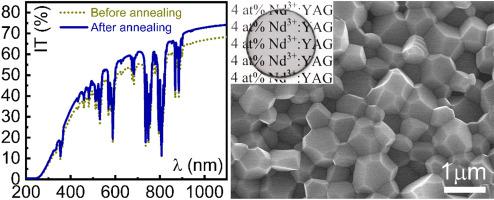Optical Materials ( IF 3.8 ) Pub Date : 2020-12-25 , DOI: 10.1016/j.optmat.2020.110760 D.Yu. Kosyanov , A.A. Vornovskikh , A.M. Zakharenko , E.A. Gridasova , R.P. Yavetskiy , M.V. Dobrotvorskaya , A.V. Tolmachev , O.O. Shichalin , E.K. Papynov , A.Yu. Ustinov , V.G. Kuryavyi , A.A. Leonov , S.A. Tikhonov

|
Fine-grained 4 at% Nd3+:YAG transparent ceramics were prepared by reactive spark plasma sintering using a two-step heating profile. The effect of key sintering parameters (heating rate, external pressure, sintering and post-annealing temperatures) on densification peculiarities, optical and mechanical properties was investigated. Special attention was paid to the behavior and nature of carbon contaminations, dispersed in the yttrium aluminum garnet matrix. It was established that the optimal heating rate to the isothermal exposure temperature was 15 °C min−1. In this case, supporting the uniformity of temperature field distribution between the punches ensures the synthesis of the single-phase product and positive densification dynamics throughout the sintering trajectory for the disk geometry of samples. It was shown that an increase in applied pressure from 30 to 70 MPa changed the color of ceramics: the samples darkened and became dark brown. This may be due to an increase in the concentration of oxygen vacancy defects (color centers). The formation of silicon oxycarbides SiOxCy (where x + y = 4; x,y ≥ 1) in ceramics at sintering temperatures T > 1400 °C was revealed by X-ray photoelectron spectroscopy. It was found that these impurity phases demonstrated a thermal stability and resistance to decomposition during post-annealing. The study showed that 4 at% Nd3+:YAG ceramics obtained by reactive spark plasma sintering at 1350°С//10 min//30 MPa//15 °C min−1 and post-annealed at 900 °C for 1 h possessed a mean grain size of 0.74 μm, a microhardness of 13.2 GPa, a residual porosity of 0.0192 vol% and in-line optical transmittance 73.7% at λ = 1064 nm, which is 0.87 from the theoretical value for a single crystal.
中文翻译:

烧结参数对SPSed Nd 3+:YAG反应性陶瓷透明性的影响
使用两步加热曲线,通过反应性火花等离子体烧结,制备了细粒4 at%Nd 3+:YAG透明陶瓷。研究了关键烧结参数(加热速率,外部压力,烧结和退火后温度)对致密化特性,光学和机械性能的影响。特别注意分散在钇铝石榴石基质中的碳污染物的行为和性质。已确定到等温暴露温度的最佳加热速率为15°C min -1。在这种情况下,支持冲头之间温度场分布的均匀性可确保在样品盘几何形状的整个烧结轨迹中合成单相产物并具有正的致密化动力学。结果表明,施加压力从30 MPa增加到70 MPa,改变了陶瓷的颜色:样品变黑并变成深棕色。这可能是由于氧空位缺陷(色心)的浓度增加所致。碳氧化硅SiO x C y的形成X射线光电子能谱揭示了在烧结温度T> 1400°C的陶瓷中(x + y = 4; x,y≥1)。发现这些杂质相在后退火期间表现出热稳定性和抗分解性。研究表明,通过在1350°С// 10 min // 30 MPa // 15°C min -1下进行反应性火花等离子体烧结,然后在900°C下退火1 h,得到4 at%Nd 3+:YAG陶瓷具有0.74μm的平均晶粒尺寸,13.2 GPa的显微硬度,0.0192 vol%的残余孔隙率和在λ= 1064 nm处的在线光学透射率73.7%,与单晶理论值相比为0.87。









































 京公网安备 11010802027423号
京公网安备 11010802027423号